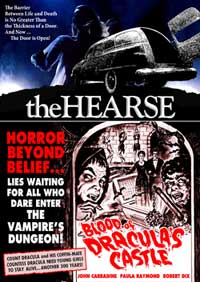 KATARINA’S
NIGHTMARE THEATER: THE HEARSE (1980)/BLOOD
OF DRACULA’S CASTLE (1969)
KATARINA’S
NIGHTMARE THEATER: THE HEARSE (1980)/BLOOD
OF DRACULA’S CASTLE (1969)Directors: George Bowers and Al Adamson
Scorpion Releasing
 KATARINA’S
NIGHTMARE THEATER: THE HEARSE (1980)/BLOOD
OF DRACULA’S CASTLE (1969)
KATARINA’S
NIGHTMARE THEATER: THE HEARSE (1980)/BLOOD
OF DRACULA’S CASTLE (1969)A strangely mismatched Crown International horror double bill from Scorpion Releasing pairs Al Adamson’s BLOOD OF DRACULA’S CASTLE (now with the long missing TV-exclusive werewolf footage) and the 1980s chiller THE HEARSE in a brand new transfer from the original negatives.

Just getting over a nervous breakdown following her divorce, schoolteacher Jane Hardy (Trish Van Devere, THE LAST RUN) decides to get away from San Francisco for the summer and take possession of the house her mother inherited from her mysterious Aunt several years ago. Arriving in the town of Blackwood at night, Jane’s car is nearly run off the road by a hearse. As soon as she gets in the door of her house, her aunt’s attorney Pritchard (Joseph Cotton, BARON BLOOD) is pressing her to sell it to him. Pritchard is not the only one who is less than welcoming. Shops won’t deliver to her house, nor will any handymen go near the property, and the children think she’s a ghost. The only friends she finds in the village are the local priest Reverend Winston (Donald Hotton, ONE DARK NIGHT) and Paul (Perry Lang, ALLIGATOR), the lovestruck son of the hardware store owner who agrees to fix up Jane’s house on his free time. Jane discovers her aunt’s diary and learns that she jilted her preacher fiancé for a mysterious man named Robert, who wanted her to join him in a pact with Satan. Jane starts seeing the apparition of her aunt, doors close by themselves, a light in the attic has a life of its own, and the hearse and its scarred driver (Dominic Barto, SHAFT) start stalking her. When Pritchard tells her that the hearse driver her aunt’s coffin got into a fiery wreck and the body was never recovered from the wreckage, she begins to suspect that Pritchard is behind efforts to get her to leave town. After another encounter with the hearse, she makes the acquaintance of charming Tom Sullivan (David Gautreaux, STAR TREK: THE MOTION PICTURE) with whom she begins the first romantic relationship following her disastrous marriage; however, the hauntings escalate with actual physical attacks from the hearse’s driver. Is Jane cracking up again, is Pritchard “gaslighting” her, or is there something more sinister going on?
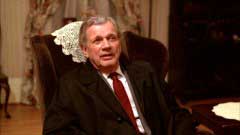 Despite
its loftier intentions – for a Crown International release – THE
HEARSE is best half-remembered as a “late night TV” chiller even
though it is a theatrical feature (that’s not necessarily a bad thing
given some of the memorable TV horror movies put out in the 1970s and 1980s).
The film is rich in atmosphere thanks to some nice Griffith Park locations,
Mori Kawa’s moody cinematography, and Webster Lewis’ piano-and-string-driven
score (Lewis also scored director George Bowers’ MY TUTOR and BODY AND
SOUL), but its elements never quite coalesce. A few scant run-ins with unfriendly
townspeople fail to establish an atmosphere of superstition or hostility, and
little children seem to be aware of Jane’s house being haunted while the
teenage characters do not. Paul hanging around Jane’s house and hinting
to his friends that he has something going with her do not culminate in anything
more than a bit of awkwardness when the visiting priest is surprised at Paul’s
presence. The priest also points out that Jane’s locket has a likeness
of Satan on it, and that she had better not let anyone in town see it, but that
also leads nowhere; in fact the whole Satanic pact subplot probably could have
been left out in lieu of a more traditional cause for the haunting (or perhaps
some actual ambiguity as to whether the hearse’s persecution of Jane is
an embodiment of her neurosis). Although Cotton’s lawyer does pop up every
once in a while to be sinister, it’s pretty obvious that he’s a
red herring and that Gautreaux’s “old-fashioned” suitor is
not at all what he seems. The titular hearse is creepy the first time it shows
up, but most of the night driving scenes are just too dark (which does work
to the film’s advantage once in keeping the viewer wondering if an approaching
car intends to help or harm Jane after her car is run off the road by the hearse),
but Bowers does manage an effective jump scare with the driver. Hotton’s
priest abruptly becomes a major character more than half-way through the film
and gets to attempt a hokey exorcism with little motivation.
Despite
its loftier intentions – for a Crown International release – THE
HEARSE is best half-remembered as a “late night TV” chiller even
though it is a theatrical feature (that’s not necessarily a bad thing
given some of the memorable TV horror movies put out in the 1970s and 1980s).
The film is rich in atmosphere thanks to some nice Griffith Park locations,
Mori Kawa’s moody cinematography, and Webster Lewis’ piano-and-string-driven
score (Lewis also scored director George Bowers’ MY TUTOR and BODY AND
SOUL), but its elements never quite coalesce. A few scant run-ins with unfriendly
townspeople fail to establish an atmosphere of superstition or hostility, and
little children seem to be aware of Jane’s house being haunted while the
teenage characters do not. Paul hanging around Jane’s house and hinting
to his friends that he has something going with her do not culminate in anything
more than a bit of awkwardness when the visiting priest is surprised at Paul’s
presence. The priest also points out that Jane’s locket has a likeness
of Satan on it, and that she had better not let anyone in town see it, but that
also leads nowhere; in fact the whole Satanic pact subplot probably could have
been left out in lieu of a more traditional cause for the haunting (or perhaps
some actual ambiguity as to whether the hearse’s persecution of Jane is
an embodiment of her neurosis). Although Cotton’s lawyer does pop up every
once in a while to be sinister, it’s pretty obvious that he’s a
red herring and that Gautreaux’s “old-fashioned” suitor is
not at all what he seems. The titular hearse is creepy the first time it shows
up, but most of the night driving scenes are just too dark (which does work
to the film’s advantage once in keeping the viewer wondering if an approaching
car intends to help or harm Jane after her car is run off the road by the hearse),
but Bowers does manage an effective jump scare with the driver. Hotton’s
priest abruptly becomes a major character more than half-way through the film
and gets to attempt a hokey exorcism with little motivation.
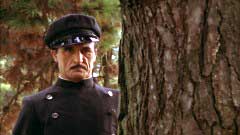
Comparisons with THE CHANGLING are inevitable in its restrained approach (and the presence of Devere), but THE HEARSE will definitely not unseat the former as one of the creepiest films of 1980. THE HEARSE was Bowers’ feature debut, but he had worked as an editor prior to this on such Crown International titles as THE SISTER-IN-LAW, THE POM-POM GIRLS, VAN NUYS BLVD and GALAXINA. His background as an editor results in more assured direction of the non-expository passages, including some Steadicam prowling around Jane’s home and a stand-out nightmare sequence. Bowers’ last film as a director was 1985’s PRIVATE RESORT, but he has continued working as an editor with high profile projects like SHOOT TO KILL, TRUE BELIEVER, SLEEPING WITH THE ENEMY, A LEAGUE OF THEIR OWN, HOW STELLA GOT HER GROOVE BACK and the WALKING TALL remake, as well as forays into the fantastic with THE ADVENTURES OF BUCKAROO BANZAI ACROSS THE 8TH DIMENSION, the original THE STEPFATHER, THE GOOD SON and FROM HELL. THE HEARSE was also available as a paperback novelization from Pinnacle Books by Henry Clement. The book followed the film very closely and featured a whopping seventy-two short chapters (corresponding mostly to individual scenes or sequences). Clement had also written movie tie-ins for Blake Edwards’ DARLING LILI, John Milius’ DILLINGER, and American International’s DE SADE, as well as the CBS-TV miniseries BEACON HILL.
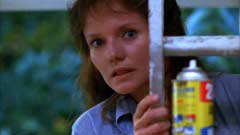 Van
Devere is easily the best thing about the film, and she goes through the horror
motions with the utmost professionalism (both as screaming heroine and in a
dual role as the apparition of her aunt, used most effectively during Jane’s
nightmare). Gautreaux does his best to make his character less obvious (introducing
a smirk into his musing over the opportunity to live forever when Jane reads
him the passage from her aunt’s diary), but his most effective moment
has him backlit and silent during the climax. Lang seems uncertain as to whether
he’s supposed to be perhaps a little obsessed with Jane, or just awkwardly
infatuated with her (Lang would also appear in Bowers’ BODY AND SOUL,
and is now a prolific TV director). Cotton is his usual cantankerous self –
or at least his screen persona in most of his later work – and really
should have had more to work with here (although the production may have only
been able to afford him for a day or two). Med Flory (THE BOOGENS) pops up intermittently
and has little to do other than leer at Jane as the town’s sheriff, and
a very young yet very recognizable Christopher McDonald (PLAYROOM) shows up
as one of Paul’s friends. Bowers’ daughter plays one of Jane’s
students in the opening scene. Producer Tenser – who is credited with
the film’s “idea” – also produced the sex comedy WEEKEND
PASS (forthcoming from Code Red), and line producer “Charles Russell”
is better known as Chuck Russell, producer of HELL NIGHT and DREAMSCAPE, and
director of A NIGHTMARE ON ELM STEET 3: DREAM WARRIORS and THE BLOB. Prop master
Ivo Cristante also did props on THE HOWLING before moving on to art direction
and production design on BAD DREAMS, TREMORS (and its first sequel), CHILD’S
PLAY 2, PUMPKINHEAD 2 and HELLRAISER: BLOODLINE.
Van
Devere is easily the best thing about the film, and she goes through the horror
motions with the utmost professionalism (both as screaming heroine and in a
dual role as the apparition of her aunt, used most effectively during Jane’s
nightmare). Gautreaux does his best to make his character less obvious (introducing
a smirk into his musing over the opportunity to live forever when Jane reads
him the passage from her aunt’s diary), but his most effective moment
has him backlit and silent during the climax. Lang seems uncertain as to whether
he’s supposed to be perhaps a little obsessed with Jane, or just awkwardly
infatuated with her (Lang would also appear in Bowers’ BODY AND SOUL,
and is now a prolific TV director). Cotton is his usual cantankerous self –
or at least his screen persona in most of his later work – and really
should have had more to work with here (although the production may have only
been able to afford him for a day or two). Med Flory (THE BOOGENS) pops up intermittently
and has little to do other than leer at Jane as the town’s sheriff, and
a very young yet very recognizable Christopher McDonald (PLAYROOM) shows up
as one of Paul’s friends. Bowers’ daughter plays one of Jane’s
students in the opening scene. Producer Tenser – who is credited with
the film’s “idea” – also produced the sex comedy WEEKEND
PASS (forthcoming from Code Red), and line producer “Charles Russell”
is better known as Chuck Russell, producer of HELL NIGHT and DREAMSCAPE, and
director of A NIGHTMARE ON ELM STEET 3: DREAM WARRIORS and THE BLOB. Prop master
Ivo Cristante also did props on THE HOWLING before moving on to art direction
and production design on BAD DREAMS, TREMORS (and its first sequel), CHILD’S
PLAY 2, PUMPKINHEAD 2 and HELLRAISER: BLOODLINE.
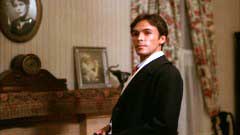
Originally released on a now hard-to-find VHS and Beta from Media Home Entertainment, THE HEARSE surprisingly made its digital bow in 2001 in a new 16:9 – albeit interlaced – transfer in 2001 from Rhino Home Video. Scorpion’s progressive, anamorphic widescreen (1.78:1) transfer comes from a brand new HD master from the original camera negatives, and it is a nice improvement. Gone is the reddish tinge over the entire image seen on the Rhino disc, and – compared to Rhino’s 1.73:1 framing – the new transfer adds more picture information to the sides and bottom of the screen (although the difference between 1.73:1 and 1.78:1 might not seem like much, but the Rhino transfer is also vertically stretched). Besides the reel change hole punches, there are a couple quickly-glimpsed large scratches; but the framing and more attractive colors make up for these minor demerits. The Dolby Digital mono audio is largely clean apart from some occasional crackling and hiss that becomes more apparent during music-only passages.
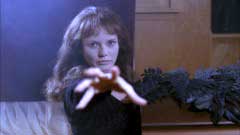 Besides
the film’s trailer (2:29), the only other extra is an audio interview
with author William Bleich (11:45). He tells us that the film’s concept
was pretty much producer Mark Tenser wanting to make a film called THE HEARSE
and the poster art. Bleich and director George Bowers scripted a gore and sex-filled
slasher script with teenagers in an abandoned house, but Tenser wanted the complete
opposite and Bleich seized the opportunity when it seemed like he might be let
go. The finished film follows his rewrite fairly closely and he is satisfied
with the final product (which actually performed well and got a single rave
review from The Los Angeles Times) despite some of Tenser’s additions
like the priest’s anticlimactic involvement in the climax. Bleich also
discusses the made-for-TV Halloween favorite THE MIDNIGHT HOUR, but does not
mention DEADLY MESSAGES (a TV chiller with Kathleen Beller and Michael Brandon
that is far more effective than THE HEARSE) or FROM THE DEAD OF NIGHT (another
made-for-TV horror film that seems highly derivative of SOLE SURVIVOR). Bleich
also wrote THE STEPFORD CHILDREN for TV and a handful of episodes of POLTERGEIST:
THE LEGACY. Bleich is now a senior lecturer at Northwestern University’s
School of Radio/Television/Film.
Besides
the film’s trailer (2:29), the only other extra is an audio interview
with author William Bleich (11:45). He tells us that the film’s concept
was pretty much producer Mark Tenser wanting to make a film called THE HEARSE
and the poster art. Bleich and director George Bowers scripted a gore and sex-filled
slasher script with teenagers in an abandoned house, but Tenser wanted the complete
opposite and Bleich seized the opportunity when it seemed like he might be let
go. The finished film follows his rewrite fairly closely and he is satisfied
with the final product (which actually performed well and got a single rave
review from The Los Angeles Times) despite some of Tenser’s additions
like the priest’s anticlimactic involvement in the climax. Bleich also
discusses the made-for-TV Halloween favorite THE MIDNIGHT HOUR, but does not
mention DEADLY MESSAGES (a TV chiller with Kathleen Beller and Michael Brandon
that is far more effective than THE HEARSE) or FROM THE DEAD OF NIGHT (another
made-for-TV horror film that seems highly derivative of SOLE SURVIVOR). Bleich
also wrote THE STEPFORD CHILDREN for TV and a handful of episodes of POLTERGEIST:
THE LEGACY. Bleich is now a senior lecturer at Northwestern University’s
School of Radio/Television/Film.
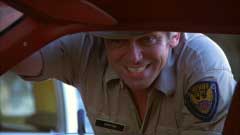
Despite the Katarina’s Nightmare Theater banner, only THE HEARSE is introduced by Katarina Leigh Waters (playing both mustached hearse driver and terrified victim) who points out actor turned TV director Cotton, Lang, Flory, Donald Hotton, Chuck Mitchell (DON’T ANSWER THE PHONE), Gautreaux, as well as McDonald. She mentions BLOOD OF DRACULA’S CASTLE in the postscript discussion of THE HEARSE but there is no intro for that film. The disc also lacks any trailers for other Katarina titles (nor the promo reel that usually rolls before the Katarina end credits).
 In
Al Adamson’s BLOOD OF DRACULA’S CASTLE, cheesecake photographer
Glen Cannon (Gene Otis Shayne, STRAWBERRIES NEED RAIN) learns that he has inherited
Falcon Rock Castle from his recently deceased 108-year-old uncle. Less-than-pleased
to learn of this development are the castle’s current tenants the Count
(Alex D’Arcy, HORROR OF SPIDER ISLAND) and Countess Townsend (Paula Raymond,
HAND OF DEATH). They have lived in the castle for sixty years although they
appear to be in their forties; this is because they are actually the Count and
Countess Dracula, and they have eluded suspicion by living in seclusion with
the aid of nightly “stimulants” supplied by dutiful moon-worshipping
butler George (John Carradine, HOUSE OF DRACULA) and donated from various young
girls chained up in the basement (courtesy of hulking, scarred Mango [Ray Young,
BLUE SUNSHINE]). Of course, having to move would be highly inconvenient, especially
since the Count has just arranged for the escape of psychotic killer Johnny
(Robert Dix, already the LAS VEGAS STRANGLER) whose good looks will enable him
to supply a greater variety of young victims. When Glenn and his “robust”
bikini model fiancé Liz (Jennifer Bishop, THE HOUSE OF TERROR) arrive
– the Count passes off his youth by saying that he is the son of the man
who leased the castle – they are not at all interested in selling since
the castle would make a good backdrop for Glenn to get Liz on magazine covers
for Universal. Since Plan A has failed to purchase the castle, the Townsends
have to resort to Plan B: kill them.
In
Al Adamson’s BLOOD OF DRACULA’S CASTLE, cheesecake photographer
Glen Cannon (Gene Otis Shayne, STRAWBERRIES NEED RAIN) learns that he has inherited
Falcon Rock Castle from his recently deceased 108-year-old uncle. Less-than-pleased
to learn of this development are the castle’s current tenants the Count
(Alex D’Arcy, HORROR OF SPIDER ISLAND) and Countess Townsend (Paula Raymond,
HAND OF DEATH). They have lived in the castle for sixty years although they
appear to be in their forties; this is because they are actually the Count and
Countess Dracula, and they have eluded suspicion by living in seclusion with
the aid of nightly “stimulants” supplied by dutiful moon-worshipping
butler George (John Carradine, HOUSE OF DRACULA) and donated from various young
girls chained up in the basement (courtesy of hulking, scarred Mango [Ray Young,
BLUE SUNSHINE]). Of course, having to move would be highly inconvenient, especially
since the Count has just arranged for the escape of psychotic killer Johnny
(Robert Dix, already the LAS VEGAS STRANGLER) whose good looks will enable him
to supply a greater variety of young victims. When Glenn and his “robust”
bikini model fiancé Liz (Jennifer Bishop, THE HOUSE OF TERROR) arrive
– the Count passes off his youth by saying that he is the son of the man
who leased the castle – they are not at all interested in selling since
the castle would make a good backdrop for Glenn to get Liz on magazine covers
for Universal. Since Plan A has failed to purchase the castle, the Townsends
have to resort to Plan B: kill them.

Even though it is an Al Adamson film, one feels that BLOOD OF DRACULA’S CASTLE really should be more entertaining than it is. Firstly, it’s got a great cast. D’Arcy and Raymond are amusingly tongue-in-cheek, but the wit is sub-ADDAMS FAMILY/THE MUNSTERS. Dix (son of actor Richard Dix) is more entertaining as the knife-flicking psychopath, and Carradine is his usual entertaining self even if he can bring very little gravitas to his Luna-worshipping butler. Vicki Volante, whose entire brief filmography was comprised of Al Adamson pictures, appears here as a motorist who gets nabbed by Mango and chained up in the castle dungeon (Adamson reportedly pursued her romantically before he met Regina Carroll). The story is fairly predictable, but the pacing is endlessly padded (even without the additional TV footage). The pre-credits sequence seems like it was drawn out to play Gil Bernal’s admittedly groovy “Next Train Out” song in its entirety, and then after the credits we are treated to an interminable photo shoot sequence at Sea World. The young couple does not even arrive at the castle until nearly forty minutes into the film (before which we’ve only seen them in two long expository scenes). The scenes with the Townsends and George the butler are more entertaining yet very statically shot, but the dungeon scenes are at least more visually interesting although not particularly exploitative enough (the sets for the dungeon were reused in TERROR AT ORGY CASTLE). After the couple arrives, it’s the usual wandering down hallways (or hallway since the real Castle Ranch location isn’t as big as the filmmakers would like you to think it is and the sets are even smaller) following weird noises and accepting excuses about the wind. The sacrifice to Luna sequence is a nice bit of action that opens up the setting a bit more, but the finale is ridiculously slapdash.
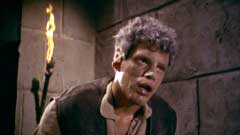 Dix,
Carradine, Raymond, Volante, Young, and stuntman/production manager John “Bud”
Cardos had next appeared together in Adamson’s western FIVE BLOODY GRAVES
(a Techniscope film shot by Vilmos Zgismond that has sadly survived only in
panned-and-scanned form). While Dix and Carradine could be called an Adamson
regular with five films and seven films appearances under their belts respectively,
Cardos worked on about as many Adamson films but in multiple capacities a producer,
production manager, stunt man and extra. Bishop also appeared (with Dix) in
Adamson’s HORROR OF THE BLOOD MONSTERS (Adamson shot footage of a space
mission around color-tinted black and white stock footage from a Filipino horror
film) as well as Adamson’s rape-revenge flick JESSI’S GIRLS and
THE FEMALE BUNCH. Bishop also appeared in Robert Slatzer’s BIGFOOT (with
Carradine) and the William Grefe duo IMPULSE (with William Shatner) and MAKOS:
JAWS OF DEATH. Shayne also appeared in Adamson’s HELL’S BLOODY DEVILS.
Much of the score is recycled from Harry Lubin’s OUTER LIMITS scoring
work, with some additional cheesy music by Don Hulette (HORROR HIGH).
Dix,
Carradine, Raymond, Volante, Young, and stuntman/production manager John “Bud”
Cardos had next appeared together in Adamson’s western FIVE BLOODY GRAVES
(a Techniscope film shot by Vilmos Zgismond that has sadly survived only in
panned-and-scanned form). While Dix and Carradine could be called an Adamson
regular with five films and seven films appearances under their belts respectively,
Cardos worked on about as many Adamson films but in multiple capacities a producer,
production manager, stunt man and extra. Bishop also appeared (with Dix) in
Adamson’s HORROR OF THE BLOOD MONSTERS (Adamson shot footage of a space
mission around color-tinted black and white stock footage from a Filipino horror
film) as well as Adamson’s rape-revenge flick JESSI’S GIRLS and
THE FEMALE BUNCH. Bishop also appeared in Robert Slatzer’s BIGFOOT (with
Carradine) and the William Grefe duo IMPULSE (with William Shatner) and MAKOS:
JAWS OF DEATH. Shayne also appeared in Adamson’s HELL’S BLOODY DEVILS.
Much of the score is recycled from Harry Lubin’s OUTER LIMITS scoring
work, with some additional cheesy music by Don Hulette (HORROR HIGH).

DP “Leslie Kovacs” is, of course, Laszlo Kovacs who had just shot EASY RIDER and was on his way to bigger (although not necessarily better) things from like SHAMPOO, F.I.ST., and GHOSTBUSTERS among others. Kovacs had fled from communist Hungary along with fellow cinematographer Vilmos Zgismond, who would shoot Adamson’s PSYCHO-A-GO-GO (which was reworked into BLOOD OF GHASTLY HORROR), SATAN’S SADISTS, FIVE BLOODY GRAVES and the insert footage for HORROR OF THE BLOOD MONSTERS (Kovacs would assist Zgismond on early assignments like Ray Dennis Steckler’s THE INCREDIBLY STRANGE CREATURES WHO STOPPED LIVING AND BECAME MIXED-UP ZOMBIES and Ib Melchior’s THE TIME TRAVELER and do second unit on some later higher profile assignments like THE ROSE, BLOW-OUT, CLOSE ENCOUNTERS OF THE THIRD KIND and SLIVER). Arriving in this country, Kovacs’s career during the 1960s included a mix of exploitation (KISS ME QUICK, THE NOTORIOUS DAUGHTER OF FANNY HILL, A SMELL OF HONEY A SWALLOW OF BRINE and MANTIS IN LACE among others) and more mainstream work like Richard Rush’s PSYCH-OUT, Peter Bogdanovich’s TARGETS and Matt Cimber’s SINGLE ROOM FURNISHED. Kovacs would also shoot Adamson’s HELL’S BLOODY DEVILS. Associate producer/editor Ewing Miles Brown would later produce and cut HORROR OF THE BLOOD MONSTERS and direct two low budget horror films himself years later while executive producer/writer Rex Carlton would produce HELL’S BLOODY DEVILS (Carlton also produced the Crown titles THE DEVIL’S HAND and NIGHTMARE IN WAX, as well was the better-known THE BRAIN THAT WOULDN’T DIE). Producer Martin B. Cohen produced NIGHTMARE IN WAX the year before and would later produce HUMANOIDS FROM THE DEEP and THE HOUSE WHERE EVIL DWELLS.
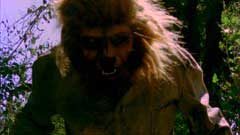 Like
many a Crown International release, BLOOD OF DRACULA’S CASTLE first arrived
on VHS stateside courtesy of VCI (now very hard to find), then as an AIR Video
big-box, and later through Interglobal (first as an SP rental with a black slipcase
cover and then later as an LP or EP sell-through with the usual blue-bordered
slipcase) and Best Film and Video (the latter two are probably the easiest to
find). Rhino released it on DVD using a fullscreen master. BCI’s double
bill of BLOOD OF DRACULA’S CASTLE and NIGHTMARE IN WAX represented the
first widescreen transfer of the theatrical version, but the release was cancelled
(although some copies apparently got out, and the newer widescreen transfers
have appeared on some of current Crown library owner Mill Creek’s box
sets). As with other Crown International titles, the TV version of BLOOD OF
DRACULA’S CASTLE transformed Dix’s killer into a literal werewolf
courtesy of some interminable stalking sequences with an actor in a terrible
Halloween mask (of course, the theatrical version actually sets this up by having
Dix’s psychosis effected by the full moon). These sequences do not match
the rest of the film in film stock or style, and the almost solarized look of
some shots may be a fault of the production, the elements, or an intentional-
if-murky effect. The electronic music for these sequences also is very different
from the rest of the patchwork score. Video releases and Rhino Home Video’s
DVD release of the film – as part of one of their Crown International
HORRIBLE HORRORS sets – have represented the theatrical cut of the film
(Sinister Cinema seemed to be the only source for the TV version for some time).
I’d like to say that it would have been nice if Scorpion had paired THE
HEARSE with another title and given us both cuts of BLOOD OF DRACULA’S
CASTLE (some online sales listings mistakenly refer to this as a 2-disc release),
but then I’d have to wonder if the film is that much more entertaining
or not without the werewolf footage.
Like
many a Crown International release, BLOOD OF DRACULA’S CASTLE first arrived
on VHS stateside courtesy of VCI (now very hard to find), then as an AIR Video
big-box, and later through Interglobal (first as an SP rental with a black slipcase
cover and then later as an LP or EP sell-through with the usual blue-bordered
slipcase) and Best Film and Video (the latter two are probably the easiest to
find). Rhino released it on DVD using a fullscreen master. BCI’s double
bill of BLOOD OF DRACULA’S CASTLE and NIGHTMARE IN WAX represented the
first widescreen transfer of the theatrical version, but the release was cancelled
(although some copies apparently got out, and the newer widescreen transfers
have appeared on some of current Crown library owner Mill Creek’s box
sets). As with other Crown International titles, the TV version of BLOOD OF
DRACULA’S CASTLE transformed Dix’s killer into a literal werewolf
courtesy of some interminable stalking sequences with an actor in a terrible
Halloween mask (of course, the theatrical version actually sets this up by having
Dix’s psychosis effected by the full moon). These sequences do not match
the rest of the film in film stock or style, and the almost solarized look of
some shots may be a fault of the production, the elements, or an intentional-
if-murky effect. The electronic music for these sequences also is very different
from the rest of the patchwork score. Video releases and Rhino Home Video’s
DVD release of the film – as part of one of their Crown International
HORRIBLE HORRORS sets – have represented the theatrical cut of the film
(Sinister Cinema seemed to be the only source for the TV version for some time).
I’d like to say that it would have been nice if Scorpion had paired THE
HEARSE with another title and given us both cuts of BLOOD OF DRACULA’S
CASTLE (some online sales listings mistakenly refer to this as a 2-disc release),
but then I’d have to wonder if the film is that much more entertaining
or not without the werewolf footage.

While the TV versions of POINT OF TERROR and BLOOD MANIA have become harder to see in the digital age (although the censored TV cuts of HORROR HIGH and DON’T ANSWER THE PHONE made it onto the Rhino sets), Scorpion has brought us the TV version of BLOOD OF DRACULA’S CASTLE in a brand new anamorphic widescreen (1.78:1) transfer. Since nothing appears to have been cut for TV, this version (titled simply DRACULA’S CASTLE) actually runs longer at 91 minutes compared to the 84 minute theatrical version. The film opens with a “Paragon International Pictures presents” credit as opposed to the theatrical version’s “Crown International presents a Paragon International presentation” card with the Crown logo in between. The body of the theatrical version appears to be a composite of multiple sources with some scenes grainier than others, some shots softer than others, and some of the compositions seem thrown off by the 1.78:1 framing (but it may just be that the film isn’t that well photographed). The werewolf scenes are particularly poor quality, but – as mentioned above – that might be either the quality of the source materials or the original shooting. Some shots are day-for-night tinted while others are not, some are sharper than others, and a couple night shots of the werewolf are almost solarized (but some shots may even have been darkened when they saw how ridiculous the werewolf mask looked on film). The quality of the Dolby Digital mono track is also variable, but I seriously doubt we’re going to see anything better from this Crown title in an official release.
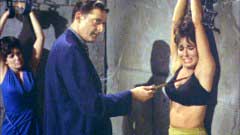 As
mentioned above, Katarina Leigh Waters does not provide an introduction for
the film; however she does appear on-camera with stuntman/production manager
John “Bud” Cardos for a “Kat’s Eyes” interview
(30:06). His father was the manager at the Egyptian Theater and his uncle the
manager at Roman’s Chinese, and he began acting as a child with bit parts
in THE LITTLE RASCALS. As a teenager, he worked at the stables that hired out
horses for westerns and started working as a stuntman. He has fond reminiscences
of working on BLOOD OF DRACULA’S CASTLE and of the cast (he and Dix met
on a Mexican-shot western and are still friends to this day). He discusses his
work as an actor, production manager, and stuntman on a number of films and
how that lead to his first directing job. A western was being lensed in 16mm
in Ohio and the producers were concerned about its progress. Cardos screened
it and said the footage was unusable. They hired him as unit production manager
to create a new budget for 35mm, and he told them he could stick to the budget
if they let him direct it; and that’s how RED, WHITE, AND BLACK became
SOUL SOLDIER. He tells an amusing anecdote about auditioning lead actresses
for KINGDOM OF THE SPIDERS (he took out a tarantula and handed to the actresses,
and Tiffany Bolling was the only one who didn’t freak out). He also discusses
his later collaborations with producer Harry Alan Towers beginning with OUTLAW
OF GOR in South Africa (director Fritz Kiersch was supposed to direct both GOR
films but got behind schedule on the first film), followed by SKELETON COAST
and then ACT OF PIRACY. It’s a slightly overlong talk, but he mentions
a number of projects that he did second unit work on without credit (before
it became a requirement to assign credit) including a couple days on THE WILD
BUNCH. Unfortunately, no trailer for BLOOD OF DRACULA’S CASTLE has been
included (and there certainly was one). (Eric Cotenas)
As
mentioned above, Katarina Leigh Waters does not provide an introduction for
the film; however she does appear on-camera with stuntman/production manager
John “Bud” Cardos for a “Kat’s Eyes” interview
(30:06). His father was the manager at the Egyptian Theater and his uncle the
manager at Roman’s Chinese, and he began acting as a child with bit parts
in THE LITTLE RASCALS. As a teenager, he worked at the stables that hired out
horses for westerns and started working as a stuntman. He has fond reminiscences
of working on BLOOD OF DRACULA’S CASTLE and of the cast (he and Dix met
on a Mexican-shot western and are still friends to this day). He discusses his
work as an actor, production manager, and stuntman on a number of films and
how that lead to his first directing job. A western was being lensed in 16mm
in Ohio and the producers were concerned about its progress. Cardos screened
it and said the footage was unusable. They hired him as unit production manager
to create a new budget for 35mm, and he told them he could stick to the budget
if they let him direct it; and that’s how RED, WHITE, AND BLACK became
SOUL SOLDIER. He tells an amusing anecdote about auditioning lead actresses
for KINGDOM OF THE SPIDERS (he took out a tarantula and handed to the actresses,
and Tiffany Bolling was the only one who didn’t freak out). He also discusses
his later collaborations with producer Harry Alan Towers beginning with OUTLAW
OF GOR in South Africa (director Fritz Kiersch was supposed to direct both GOR
films but got behind schedule on the first film), followed by SKELETON COAST
and then ACT OF PIRACY. It’s a slightly overlong talk, but he mentions
a number of projects that he did second unit work on without credit (before
it became a requirement to assign credit) including a couple days on THE WILD
BUNCH. Unfortunately, no trailer for BLOOD OF DRACULA’S CASTLE has been
included (and there certainly was one). (Eric Cotenas)